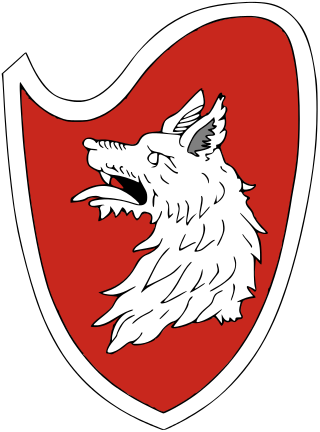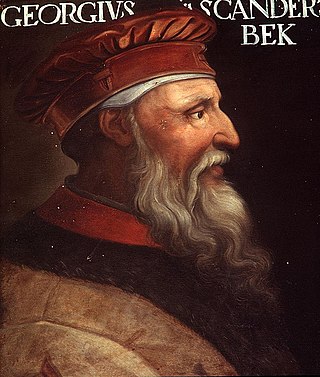
Lekë III Dukagjini (1410–1481), mostly known as Lekë Dukagjini, was a 15th-century member of the Albanian nobility, from the Dukagjini family. A contemporary of Skanderbeg, Dukagjini is known for the Kanuni i Lekë Dukagjinit, a code of law instituted among the tribes of northern Albania.
Gjon Kastrioti was a member of the Albanian nobility from the House of Kastrioti and the father of future Albanian leader Gjergj Kastrioti. He governed the territory between the Cape of Rodon and Dibër and had at his disposal an army of 2,000 horsemen.
Stefan Crnojević, known as Stefanica was the Lord of Zeta between 1451 and 1465. Until 1441, as a knyaz he was one of many governors in Upper Zeta, which at that time was a province of the Serbian Despotate. He then aligned himself with the Bosnian duke, Stefan Vukčić Kosača, and remained his vassal until 1444 when he accepted Venetian suzerainty. In Venetian–held Lezhë, on 2 March 1444, Stefan and his sons forged an alliance with several noblemen from Albania, led by Skanderbeg, known as the League of Lezhë. In 1448 he returned under suzerainty of Serbian Despot Đurađ Branković. In 1451, Stefan took over the leadership of the Crnojević family and became the ruler of a large part of Zeta, hence the title Gospodar Zetski.

Gjergj Kastrioti, commonly known as Skanderbeg, was an Albanian feudal lord and military commander who led a rebellion against the Ottoman Empire in what is today Albania, North Macedonia, Greece, Kosovo, Montenegro, and Serbia.
The term Albanian principalities refers to a number of principalities created in the Middle Ages in Albania and the surrounding regions in the western Balkans that were ruled by Albanian nobility. The 12th century marked the first Albanian principality, the Principality of Arbanon. It was later, however, in the 2nd half of the 14th century that these principalities became stronger, especially with the fall of the Serbian Empire after 1355. Some of these principalities were notably united in 1444 under the military alliance called League of Lezhë up to 1480 which defeated the Ottoman Empire in more than 28 battles. They covered modern day Albania,western and central Kosovo, Epirus, areas up to Corinth, western North Macedonia, southern Montenegro. The leaders of these principalities were some of the most noted Balkan figures in the 14th and 15th centuries such as Gjin Bue Shpata, Andrea II Muzaka, John Zenevisi, Karl Topia, Andrea Gropa, Balsha family, Gjergj Arianiti, Gjon Kastrioti, Skanderbeg, Dukagjini family and Lek Dukagjini.

The Albanian–Venetian War of 1447–48 was waged between Venetian and Ottoman forces against the Albanians under George Kastrioti Skanderbeg. The war was the result of a dispute between the Republic and the Dukagjini family over the possession of the Dagnum fortress. Skanderbeg, then ally of the Dukagjini family, moved against several Venetian held towns along the Albanian coastline, in order to pressure the Venetians into restoring Dagnum. In response, the Republic sent a local force to relieve the besieged fortress of Dagnum, and urged the Ottoman Empire to send an expeditionary force into Albania. At that time the Ottomans were already besieging the fortress of Svetigrad, stretching Skanderbeg's efforts thin.
Lekë Zaharia, was an Albanian nobleman from Zaharia family. He was the only son of his father Koja Zaharia and mother Bosa who also had one daughter, Bolja, who named her son Koja after her father.
The Spani were a northern Albanian noble family. They emerged in the 14th century as an important family in the fortified town of Drivasto (Drisht) and owned large estates in the wider area of Shkodra. In the late 15th century, a large part of it settled in Venetian territories, primarily Venice itself and Dalmatia.

Sati was a medieval fortified town near Shkodër in contemporary Albania. Between 1395 and 1459, it passed through the control of the Venetian Republic, the Dukagjini family, the Ottoman Empire, and Skanderbeg, who razed it sometime after 1459.
The Humoj or Omoj was an Albanian noble family that served as pronoiars of the Republic of Venice in the region of Balec and Drisht in the 15th century.
The Albanian nobility was an elite hereditary ruling class in Albania, parts of the western Balkans and later in parts of the Ottoman world. The Albanian nobility was composed of landowners of vast areas, often in allegiance to states like the Byzantine Empire, various Serbian states, the Republic of Venice, the Ottoman Empire and the Kingdom of Naples in addition to the Albanian principalities. They often used Byzantine, Latin or Slavic titles, such as sebastokrator, despot, dux, conte and zupan.
Pal Dukagjini was an Albanian nobleman, a member of the Dukagjini family. He and his kinsman Nicholas Dukagjini were initially subjects of Lekë Zaharia, a Venetian vassal who had possessions around Shkoder. Nicholas murdered Lekë, and the Dukagjini continued to rule over their villages under Venetian vassalage. Pal and Nicholas were part of the League of Lezhë, a military alliance that sought liberation of Albania from the Ottoman Empire, founded by the powerful Skanderbeg. In 1454, the Dukagjini accepted vassalage of Alfonso V of Aragon, as other chieftains had done three years earlier. Pal later abandoned Skanderbeg's army and deserted to the Ottomans.
Nicholas Dukagjini was a 15th-century member of the Dukagjini family.
Peter Spani was an Albanian nobleman and Venetian pronoetes in the first half of the 15th century. His family's domains included territories around Shkodër (Scutari), Drisht (Drivasto) and western Kosovo. He ruled over Shala, Shosh, Nikaj-Mërtur (Lekbibaj) and Pult; the whole region under the Ottomans took his name, Petrişpan-ili. Between 1444 and 1455, Peter was a member of the League of Lezhë and after his death, the League took his territories.
Gojko Balšić or Gojko Balsha and his brothers George Strez and John were the lords of Misia, a coastal area from the White Drin towards the Adriatic. The brothers were members of the house of Balšić, which earlier held the Lordship of Zeta. They participated in founding the League of Lezhë, an alliance led by their maternal uncle Gjergj Kastrioti Skanderbeg. Gojko supported Skanderbeg until the latter's death in 1468, and then continued to fight against the Ottomans within Venetian forces.

George Strez Balšić or Gjergj Balsha and his brothers Gojko and Ivan were the lords of Misia, a coastal area from the White Drin towards the Adriatic. The brothers were members of the Balšić noble family, which had earlier held Zeta. They participated in founding of the League of Lezhë, an alliance led by their maternal uncle Skanderbeg. George later betrayed Skanderbeg, by selling a domain to the Ottomans, while his two brothers continued to support Skanderbeg until his death and then continued to fight for the Venetian forces.
This timeline lists important events relevant to the life of the Albanian feudal lord and military commander Gjergj Kastrioti Skanderbeg, widely known as Skanderbeg.

Skanderbeg's rebellion was an almost 25-year long anti-Ottoman rebellion led by the Albanian military commander Skanderbeg in what is today Albania and it's neighboring countries. It was a rare successful instance of resistance by Christians during the 15th century and through his leadership led Albanians in guerrilla warfare against the Ottomans.

The Albanian-Ottoman Wars (1432–1479) were a series of wars and revolts against the rising Ottoman Empire by Albanian feudal lords. The wars and revolts took place in present-day Albania, Montenegro, Kosovo and North Macedonia and South Serbia.







